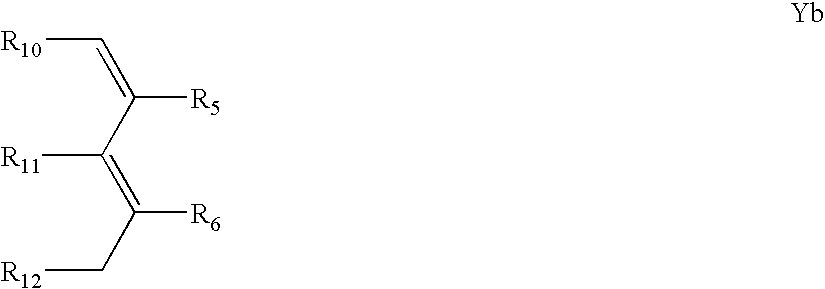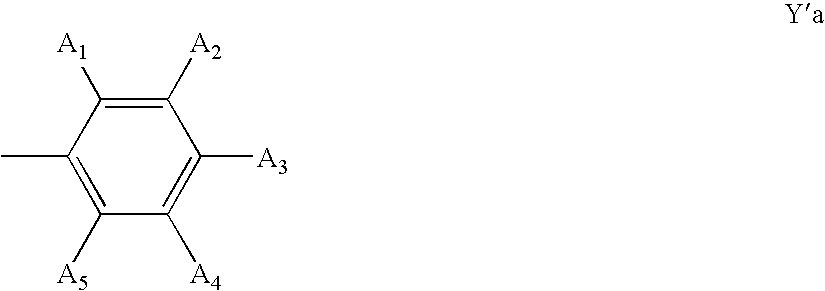Methods and compositions for enhancing detection in determinations employing cleavable electrophoretic tag reagents
a technology of electrophoretic tag and composition, which is applied in the direction of nucleotide libraries, instruments, library screening, etc., can solve the problems of high cost of arrays, confounding the accuracy of genetic information, and high cost of synthesizing arrays
- Summary
- Abstract
- Description
- Claims
- Application Information
AI Technical Summary
Problems solved by technology
Method used
Image
Examples
example 1
Synthesis of Elements of E-Tag Probes
[0393] A. Synthesis of 6-Carboxyfluorescein Phosphoramidite Derivatives
[0394] To a solution of 6-carboxyfluorescein (0.5 g, 1.32 mmol) in dry pyridine (5 mL) was added drop wise, isobutyric anhydride (0.55 mL, 3.3 mmol). The reaction was allowed to stir at room temperature under an atmosphere of nitrogen for 3 h. After removal of pyridine in vacuo the residue was redissolved in ethyl acetate (150 mL) and washed with water (150 mL). The organic layer was separated, dried over Na.sub.2SO.sub.4, filtered, and concentrated in vacuo to yield a brownish residue. This material was dissolved in CH.sub.2Cl.sub.2 (5 mL) after which N-hydroxy succinimide (0.23 g, 2.0 mmol) and dicyclohexylcarbodiimide (0.41 g, 1.32 mmol) were added. The reaction was allowed to stir at room temperature for 3 h and then filtered through a fritted funnel to remove the white solid, which had formed. To the filtrate was added aminoethanol (0.12 mL, 2.0 mmol) dissolved in 1 mL of...
example 3
Complexins of Catechol-Oligos with a Boronate Gel
[0481] Two oligonucleotides (3 and 14 mers) containing an amino group at the penultimate base were synthesized by standard procedures, purified by HPLC and then reacted with 3,4-dihydroxyphenyl acetic acid-NHS (4 mg) prepared as described above and set forth in FIG. 57, then re-purified with IIPLC. In this manner, a catechol group was introduced into the oligonucleotides. This material was added to a pre-treated Boronate Affinity Gel (Affi-Gel 601, BioRad) at pH 8 to 9 and incubated for 30 min. (see FIG. 43). The supernatant was centrifuiged and was analyzed by capillary electrophoresis using an ABI 3100 machine (Applied BioSystems, Inc., Foster City Calif.). Fluorescein was used as an internal standard. Electropherograms showing the results are depicted in FIGS. 44-48.
example 4
Singleplex Amplifications of Allele 1 and Allele 2
[0482] The experiment was set up to run in the following fashion (6 samples, a triplicate for Allele-1 and another triplicate for Allele-2):
[0483] 22 .mu.L of Mastermix
[0484] 13 .mu.L of probes and primers (both the probes are present)
[0485] 4.0 .mu.L of Allele-1 or Allele-2
[0486] 11 .mu.L of buffer (10 mM Tris-HCl, 1 mM EDTA, pH8.0)
[0487] Allele 1 was labeled with tetrachloro fluorescein (TET), and Allele 2 was labeled with fluorescein (FAM), each having characteristics as set forth in FIG. 1B.
[0488] The above volumes were added to a PCR tubes and the reaction mixtures were cycled on a Gene Amp.RTM. system 9600 thermal cycler (Perkin Elmer) as follows:
[0489] 50.degree. C.; 2 MIN (for optimal AmpErase UNG activity)
[0490] 96.degree. C.; 10 MIN (required to activate AmpliTaq Gold DNA Polymerase)
[0491] 40 cycles of:
[0492] 95.degree. C.; 15 SEC
[0493] 60.degree. C.; 60 SEC
[0494] 70.degree. C.; 10 NM
[0495] 4.degree. C.; storage
[0496] Resul...
PUM
| Property | Measurement | Unit |
|---|---|---|
| molecular weight | aaaaa | aaaaa |
| molecular weight | aaaaa | aaaaa |
| molecular weight | aaaaa | aaaaa |
Abstract
Description
Claims
Application Information
 Login to View More
Login to View More - R&D
- Intellectual Property
- Life Sciences
- Materials
- Tech Scout
- Unparalleled Data Quality
- Higher Quality Content
- 60% Fewer Hallucinations
Browse by: Latest US Patents, China's latest patents, Technical Efficacy Thesaurus, Application Domain, Technology Topic, Popular Technical Reports.
© 2025 PatSnap. All rights reserved.Legal|Privacy policy|Modern Slavery Act Transparency Statement|Sitemap|About US| Contact US: help@patsnap.com



